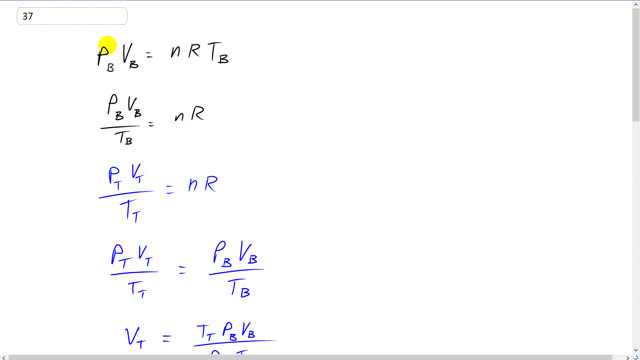
An air bubble at the bottom of a lake 41.0 m deep has a volume of . If the temperature at the bottom is and at the top , what is the radius of the bubble just before it reaches the surface?

In order to watch this solution you need to have a subscription.
This is Giancoli Answers with Mr. Dychko. The pressure at the bottom of the lake times the volume of the bubble at the bottom of the lake equals the number of moles of air in the bubble times R times the temperature at the bottom the lake. Pressure is absolute pressure and temperatures in kelvin, remember. So, let's keep that in mind as we do our calculations later. And we'll divide both sides by TB to make this PB VB over TB equals n R. And at the top, just before the bubble reaches the surface the pressure at the top times the volume of the bubble at the top divided by temperature at the top is going to equal the same n R because the number of moles in the bubble doesn't change. And so since both of these equal n R, you can say that they're equal to each other. So, P top times V top divided by T top equals P bottom V bottom divided by T bottom. And we can solve for the volume at the top and multiply both sides by temperature to the top divided by pressure at the top. And so VT equals temperature top pressure bottom times volume bottom divided by pressure top times temperature bottom. OK. So, the volume of the bubble at the top is the volume of the sphere, 4/3 π times the radius at the top cubed. And we can solve for rT cubed by multiplying both sides by 3 over 4π. And that makes 3 volume top divided by 4π. Then take the cube root of both sides which is the same as exponent 1/3 by the way, that's probably what you'll do when you plug it into calculator like exponent 1/3. And so rT is the cube root of 3 VT over 4π. So, then we substitute this in for the volume at the top. And then, you know, take this denominator, put it where it belongs, and you get radius at the top is cube root of 3 times temperature at the top times pressure at the bottom times volume at the bottom divided by 4π times pressure at the top times temperature at the bottom. Now, the pressure at the top is atmospheric pressure because this is just the bubble just before it reaches the surface. So, basically there's no water there's no height to the column of water above it, this is just at the moment it's at the surface. And so the pressure at the top is atmospheric pressure. The pressure at the bottom is going to be atmospheric pressure plus the gauge pressure due to the column of water which is 41 meters high. And so we'll substitute this and for PB here. And then we'll substitute in atmospheric pressure for pressure at the top. And then we plug in a whole bunch of numbers and we have cube root of 3 times 18.5 degrees Celsius plus 273.15, that's the temperature at the top in kelvin, times 1.013 times 10 to the 5 pascals atmospheric pressure plus the density of water, and this is a lake, so, it's fresh water, so, it's 1.00 times 10 to the 3 kilograms per cubic meter times 9.8 newtons per kilogram times 41 meters. And then close bracket. And then times by 1 cubic centimeter converted into cubic meters by multiplying by 1 meter for every 100 centimeters and then cubed. Divided by 4π times atmospheric pressure times 5.5 degrees Celsius plus 273.15. And this makes 0.010746 meters which is 1.07 centimeters, and that'll be the radius of the bubble at the top.